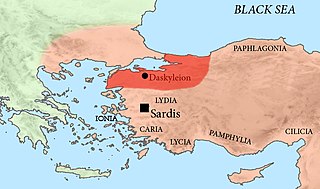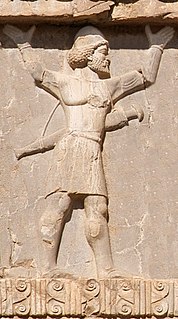 W
WAchaemenes was an Achaemenid general and satrap of ancient Egypt during the early 5th century BC, at the time of the 27th Dynasty of Egypt.
 W
WAriabignes was one of the sons of the Persian king Darius I and his mother was a daughter of Gobryas (Γοβρύας). He participated in the Second Persian invasion of Greece, as one of the four admirals of the fleet of his brother Xerxes I, and was killed in the Battle of Salamis in 480 BC. Ariabignes was the commander of the Carian and Ionian forces.
 W
WArsames was an Achaemenid Persian satrap of Cilicia in 334/3 BC. He succeeded Mazaeus in this position. He took part in the Battle of Granicus where he fought with his cavalry on the left wing, along with Arsites and Memnon of Rhodes. He was able to survive that battle and flee to the capital of Cilicia Tarsus. There he was planning a scorched-earth policy according to that of Memnon which caused the native Cilician soldiers to abandon their posts. He also decided to burn Tarsus to the ground so as not to fall in the hands of Alexander but was prevented from doing so by the speedy arrival of Parmenion with the light armored units who took the city. After that, Arsames fled to Darius who was at this time in Syria. He was slain at the battle of Issus in 333 BC.
 W
WArsites was Persian satrap of Hellespontine Phrygia in Achaemenid dinesty in the 4th century BC. His satrapy also included the region of Paphlagonia.
 W
WArtaphernes, flourished circa 513–492 BC, was a brother of the Achaemenid king of Persia, Darius I, satrap of Lydia from the capital of Sardis, and a Persian general. In his position he had numerous contacts with the Greeks, and played an important role in suppressing the Ionian Revolt.
 W
WArtaphernes, son of Artaphernes, was the nephew of Darius the Great, and a general of the Achaemenid Empire. He was a Satrap of Lydia from 492 to after 480.
 W
WArtyphius was a general of the Achaemenid Army during the Second Persian invasion of Greece. He was the son of Artabanus, grandson of Hystaspes, and therefore nephew of Darius the Great and first degree cousin of Xerxes I.
 W
WDatis or Datus, was a Median admiral who served the Persian Empire, under Darius the Great. He was an expert in Greek affairs and maintained connections with Greek officials. He is noted for his joint leadership with the younger Artaphernes of the Persian forces in the first campaign of the Persian Wars against the Greeks. His earlier career is not known.
 W
WMascames was a Persian official and military commander, who flourished during the reign of Xerxes I. He was the son of Megadostes, and was appointed governor of Doriscus in 480 BC by Xerxes I, succeeding the governor who had been appointed by Darius the Great. According to Herodotus, Mascames resisted all Greek attacks following the Second Persian invasion of Greece, and remained thus known as the only remaining Persian governor in Europe. Though the Greeks managed to clear other Persian garrisons in Europe, such as Eion, they were unable to take Doriscus from Mascames, which irked the Athenian military.
 W
WMasistius was a Persian cavalry commander best known for his role in the second Persian invasion of Greece.
 W
WMegabates was a Persian military leader in the late 6th and early 5th centuries BC. According to Herodotus he was a cousin of Darius the Great and his brother Artaphernes, satrap of Lydia.
 W
WMegabyzus was an Achaemenid Persian general, son of Zopyrus, satrap of Babylonia, and grandson of Megabyzus I, one of the seven conspirators who had put Darius I on the throne. His father was killed when the satrapy rebelled in 482 BCE, and Megabyzus led the forces that recaptured the city, after which the statue of the god Marduk was destroyed to prevent future revolts. Megabyzus subsequently took part in the Second Persian invasion of Greece. Herodotus claims that he refused to act on orders to pillage Delphi, but it is doubtful such orders were ever given.
 W
WXerxes I, commonly known as Xerxes the Great, was the fourth King of Kings of the Achaemenid Empire, ruling from 486 to 465 BC. He was the son and successor of Darius the Great and his mother was Atossa, a daughter of Cyrus the Great, the first Achaemenid king. Like his father, he ruled the empire at its territorial apex. He ruled from 486 BC until his assassination in 465 BC at the hands of Artabanus, the commander of the royal bodyguard.